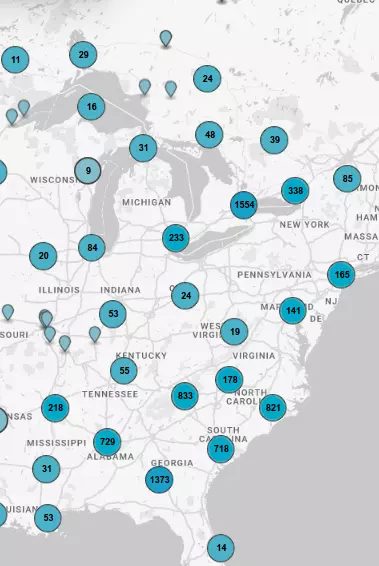Tender Frame Shop & Master Mechanic's Office
This 1855 structure served various purposes. Originally, workers built frames for steam engine tenders, and the Master Mechanic had his office in this building. The tenders built here were...
- lat34
Storehouse
This Storehouse was constructed in 1925 to hold a wide variety of supplies used by the railroad. Storehouse stock included tools and parts necessary to work on train cars, but also the many items...
- lat34
Smokestack
This Smokestack served dual purposes. Underground flues connect the stack to the Boiler Room and Blacksmith Shop. This system operated on the Bernoulli Principle. The height of the stack enabled...
- lat34
Planing Shed & Lumber Shed
Workers in the Planing Shed milled lumber for rail cars and other wooden items manufactured by the railroad. The grouping of the Planing Shed (A) and Lumber Shed (B) next to the Boiler Room (C)...
- lat34
Machine Shop
The courtyard in front of you is actually the remains of the Machine Shop. Note its walls and foundations that supported various machines. Can you find the “ghost” outline on the wall inside the...
- lat34
Drop Table
The Drop Table is located in the Roundhouse. It is a device that enabled mechanics to remove the axles and wheels of a locomotive easily. This allowed repairs to the wheel assembly and...
- lat34
Colored Shopmen's Locker & Lavatory
The railroad provided separate washroom facilities for whites and African-Americans. Facilities and opportunities were quite different for black and white people historically in the segregated...
- lat34
Boiler Room
The Boiler Room supplied power for the entire complex. The ornate design of this building symbolizes the importance of its function to the site. The Boiler Room was the heart of the site, pumping...
- lat34
Blacksmith Shop
The Blacksmith Shop had 13 forges. The railroad complex needed blacksmiths to forge iron locomotive and rolling stock parts, hinges and other hardware for buildings and also tools and equipment....
- lat34
The Parade
The Confederates used earth and a “blindage” of timbers as protection against shot and shells falling within the fort. To reduce casualties from flying debris, the “light colonnade” or...
- lat34
The Demilune
Surrounded on all sides by the moat, the demilune (literally “half-moon”) protected the vulnerable fort entrance. This triangular area was modified in 1872 by the addition of earthen mounds...
- lat34
The Breached Wall
The southeast angle of Fort Pulaski was breached by early afternoon on April 11, 1862. With devastating accuracy, Union rifled artillery accomplished this task in only 30 hours. It would take over...
- lat34
The Breached Wall / April 10-11, 1862
"The result of this bombardment must cause, I am convinced, a change in the construction of fortification as radical as that foreshadowed in naval architecture by the conflict between the Monitor...
- lat34
Store House
Colonel Edward L. Molineaux, 157th N. Y. Volunteers, left a diary describing these casemates. From here, the Quartermaster Department issued bulk supplies to the garrison. During the night of...
- lat34
Southwest Magazine
Used as a shell magazine during the Confederate occupation, the Federals saw fit to use it as “dark confinement” for Confederate Officers held prisoner during the Winter, 1864-65. Plaque courtesy...
- lat34
Southwest Bastion - Fort Pulaski
The Southwest Bastion held a special type of cannon to protect the fort’s entrance. These cannon, known as 24-pounder flank defense howitzers, were aimed at the drawbridge. Today, this area...
- lat34
Powder Magazine
By noon, April 11, 1862, shells breached the opposite side of the fort and struck this wall. Inside sat great stores of gunpowder. The fort surrendered two hours later. Plaque...
- lat34
Model 1859 Seacoast Carriage
The Phoenix Iron Works of Philadelphia made this carriage for a Parrott rifle (cannon). The weapon fired a 100 pound projectile 8500 yards. Carriage and gun weighed almost 13,000 pounds. In 1978...
- lat34
Conrad Aiken
Conrad Aiken, Poet and Man of Letters, was born in Savannah on August 5, 1889, and lived at No. 228 (opposite) until 1901. After the tragic deaths of his parents, he was moved to New England. Most...
- lat34
Hot Shot Furnace
Only the foundation remains of one of the fort’s furnaces which heated cannon balls. Used against wooden ships, the red-hot projectiles could start a disastrous fire – even after skipping on...
- lat34
